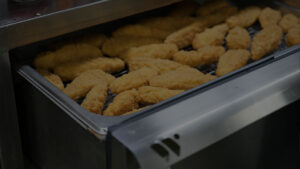This is the Manhattan Filet Project, where we’ll show how to take an old-school butcher’s secret and create one “bomb” of a steak!
Today’s consumers still love a great steak, but many of us are discouraged by the thought of eating a 16 to 24 oz behemoth…so we turn to smaller cuts, like beef tenderloin or filet. In my opinion, the filet is a bit lacking in flavor, as it is very tender but also super lean. As I continued searching for the perfect steak (in both size and taste), I rediscovered the Manhattan Cut.
The Manhattan cut is trimmed from the New York strip loin. To butcher this steak, take a traditional strip loin and butcher according to the following steps:
Trimming the Manhattan Filet
- Even the strip loin by trimming both ends of the strip loin.
- Remove back strap.
- Remove the lip from the opposite side of the loin.
- Trim strip loin well, removing most of the fat.
- Cut loin into traditional 1” to 1 ½” steaks.
- Remove all fat from the outside of the steaks.
- Divide each strip steak into two filet size steaks per NY strip steak.
*Note – Save meat trimming to make an outstanding stock, and convert to a bordelaise sauce to serve with your steaks.
You can watch a great video on butcher the Manhattan Filet from Snake River Farms.
Today, many cooks like to sous-vide their steaks to ensure perfect endpoint temperatures and tenderization. But I’m not too fond of the cost of a bag. Also, this can lead to a potential mess in a workstation with an immersion circulator. We prefer to stage in our CVap® Cook and Hold Ovens. Watch a short video here on the benefits of staging.
Our steaks were staged in our CHV5-05UV using 135°F water temp and 135°F air temp for an hour. They emerged at a perfect mid-rare. With staging, you can choose your desired doneness. Finish steaks by hard searing, grilling, or broiling.














